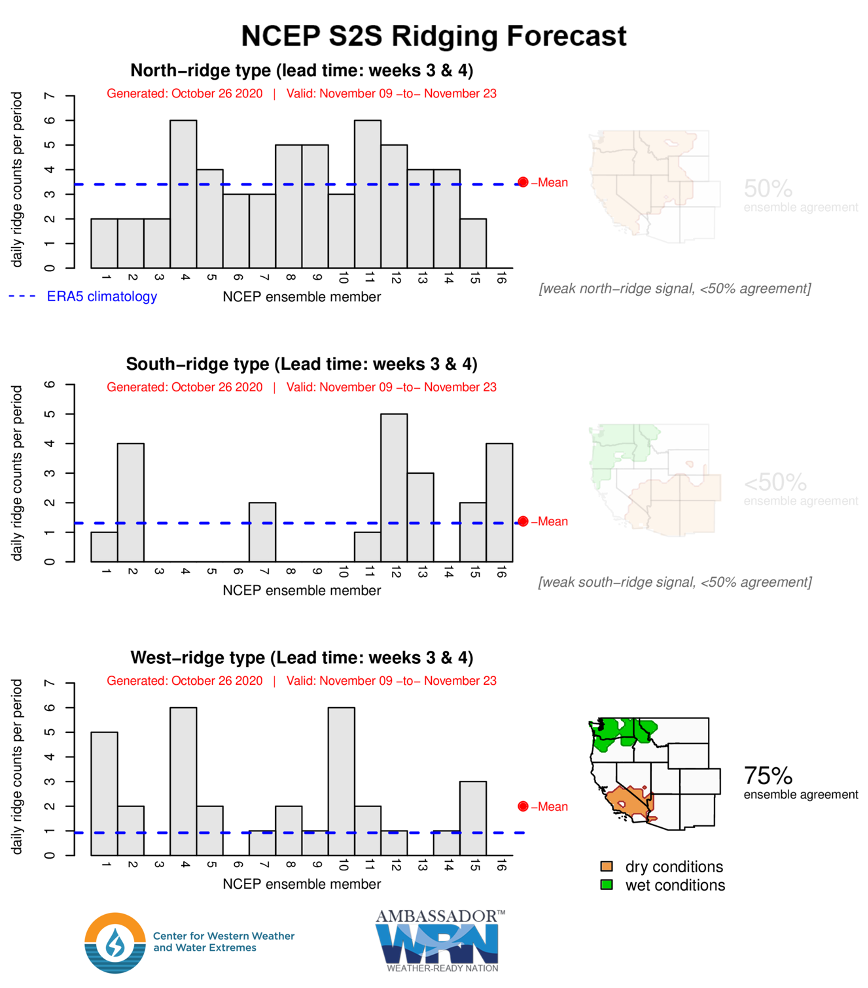New Forecast Tool Looks Out to Six Weeks for Early Signs of Ridging Conditions – A Phenomenon Key to Diverting Winter Storms and Promoting U.S. West Coast Drought
November 2, 2020
October 2020 has seen the continuation of abnormally dry conditions across much of California and the Western United States. As of the end of October, a considerable area of the Western United States is in Severe Drought or Extreme Drought, as classified by the United States Drought Monitor. On top of these severely dry conditions, downslope foehn winds have fanned multiple wildfires across the states of Washington, Oregon, California and Colorado throughout September and October. Ridging conditions, defined as extended regions of persistent high pressure in the atmosphere, play an important role in amplifying the likelihood of dry conditions across the Western United States. When ridging conditions are situated in certain key locations, the likelihood of the presence of atmospheric rivers to deliver a vital source of precipitation to the West is diminished, allowing dry conditions to persist across the water year (Gibson et al., 2020a). Forecasting when these ridging events are likely to setup and persist can therefore provide valuable information for water resource management. A new experimental forecast tool provides an extended outlook for when ridges are likely to be present in these key regions.
The new experimental forecast tool was developed by researchers at at the Center for Western Weather and Water Extremes (CW3E) at Scripps Institution of Oceanography at UC San Diego in partnership with the NASA Jet Propulsion Laboratory. The tool displays the likelihood of ridge occurrence in three different key regions, termed the North-Ridge type, the South-Ridge type, and West-Ridge type, as defined by the positioning of the ridge and associated regional precipitation anomalies. For each of these three ridge types, the forecast tool quantifies the likelihood of ridging at lead times of weeks 1 & 2, weeks 3 & 4, weeks 5 & 6, and maps the expected precipitation anomalies associated with ridging. A comprehensive hindcast skill assessment related to these forecasts is detailed in Gibson et al. (2020b).
This subseasonal-to-seasonal (S2S) product is based on input data from the National Centers for Environmental Prediction (NCEP) Climate Forecast System (CFS). The public release of the product was approved by an internal CW3E S2S Advisory Panel, co-chaired by CW3E Director Dr. F. Martin Ralph and NASA JPL Chief Scientist for Earth Sciences Dr. Duane E. Waliser. This S2S product, as well as the research that underpins the product, supports CW3E’s Strategic Plan goals for revolutionizing seasonal outlooks of extreme events in North America and their impacts on floods, drought, hydropower, and the economy.
A recent example of the weeks 3 & 4 forecast product is shown below. Forecasts are updated twice weekly on the CW3E website.
Figure: Example of the weeks 3 & 4 ridging outlook generated on October 26th 2020 and valid from November 9th to November 23rd. Across this forecast time period the West-ridge type is expected to be particularly active, with 75% of the ensemble members (grey bars) showing a higher occurrence of ridging compared to climatology (horizontal blue dashed lined). The associated precipitation pattern anomaly is shown on the right-hand side and indicates a preference for drier-than-normal conditions across southern California and wetter-than-normal conditions across Washington State.
Gibson, P. B., D. E. Waliser, B. Guan, M. J. DeFlorio, F. M. Ralph, and D. L. Swain, 2020a: Ridging associated with drought in western and southwestern United States: characteristics, trends and predictability sources. J. Climate, 33, 2485-2508, doi: https://doi.org/10.1175/JCLI-D-19-0439.1.
Gibson, P. B., Waliser, D. E., Goodman, A., DeFlorio, M. J., Delle Monache, L., and Molod, A. (2020b). Subseasonal-to-seasonal (S2S) hindcast skill assessment of ridging events related to drought over the Western United States. Journal of Geophysical Research: Atmospheres (accepted for publication).

